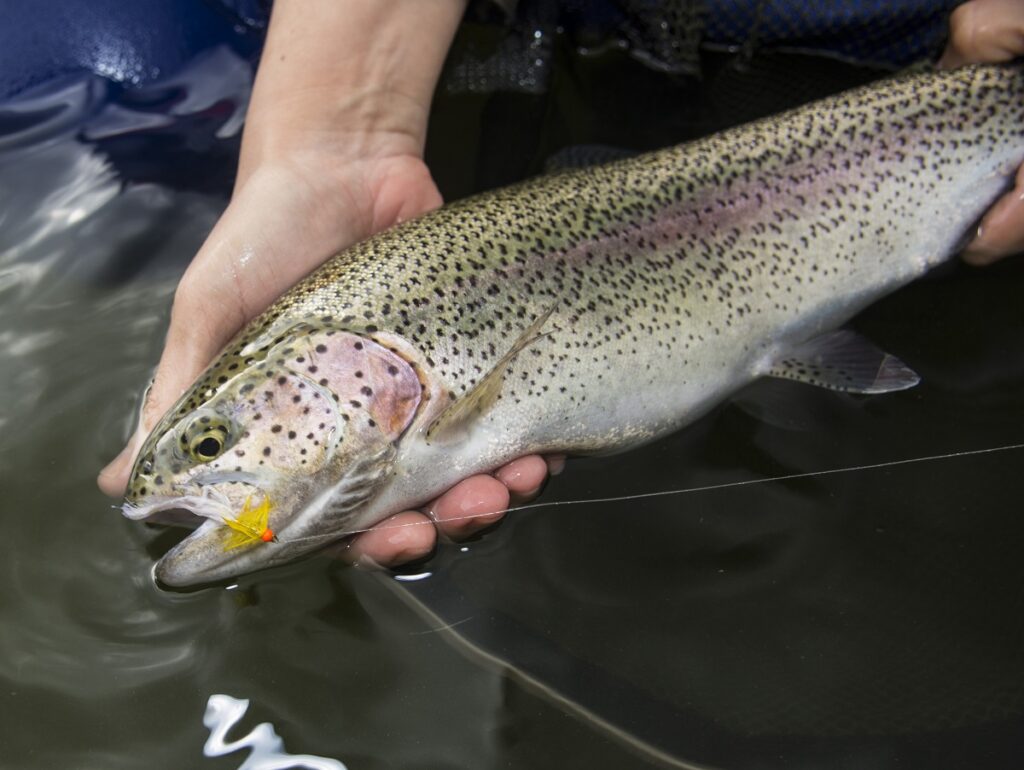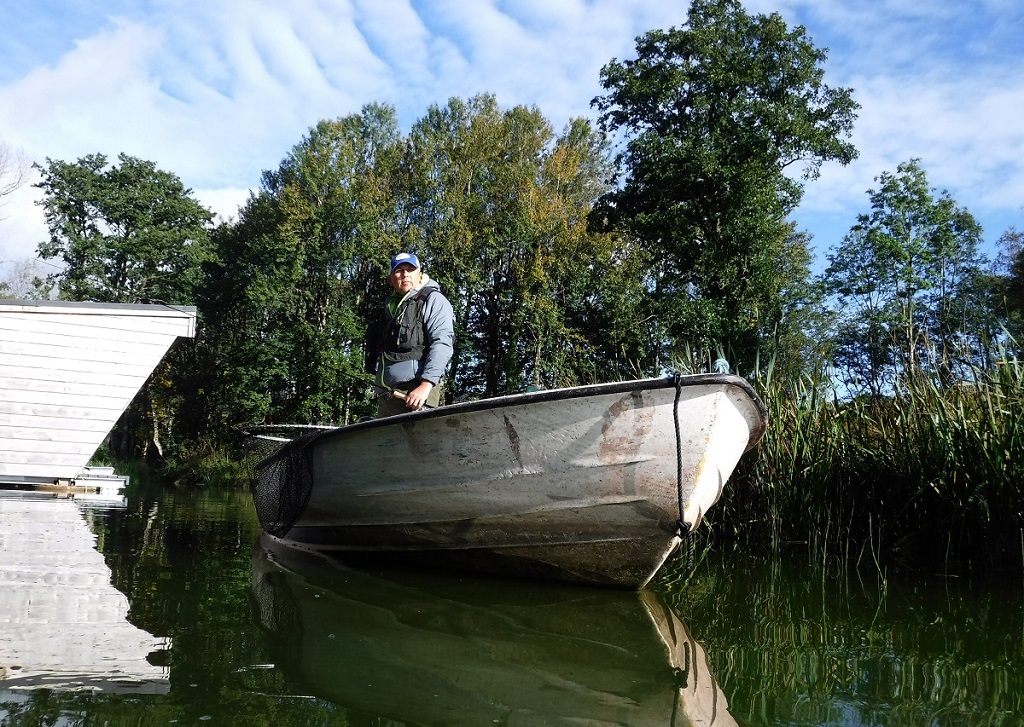Trout Fishing on Gludy Lake – Boat verses tube!
Ceri Thomas and Tim Hughes tackle Welsh small Stillwater fishery Gludy lake with two different methods afloat. Which one comes out on top?
Gludy lake is a truly magical place. Situated just outside the market town of Brecon, the naturalised stillwater has been on the map for over 150 years. Situated in a wooded hollow, a small earthen dam holds back just over 7 acres of rich, fertile water that is full of invertebrate life. Couple this with abundant coarse fish fry and it’s easy to see why the trout stocked into Gludy rapidly turn into fully finned backing stripping machines.
Managed as a trout fishery for the past 20 years, Gludy has always been run on a purely catch and release basis – so any stocked fish get the chance to mature and grow into fine specimens indeed.
The lake holds rainbows, blues, browns and even the odd tiger. Variety is key, and Chris Burgess the fishery manager for the past decade is currently enlarging a holding pond at the top of the lake that will be lightly stocked for beginners and bank stalking next year. There is also a newly constructed boat house at the top end of the lake, next to the luxurious day lodges that visiting anglers can make full use of.
Bank fishing is a little limited on Gludy due to the reedy, marshy shores and plentiful tree cover in most areas. Therefore most anglers fish from a boat. There are several different sized craft on site supplied complete with electric motors; the use of which are included with the ticket. This gives you complete freedom to fish any area of the lake you wish.
Float tubing is also allowed – one of the few venues in Wales where this special form of fishing can be enjoyed. You can bring your own or make arrangements to use one with the fishery.

Today we are looking to try the two methods side by side – Tim in one of the boats and myself in a float tube. There are pro’s and con’s to each way of fishing, so this session should make it clearer as to which one can give you the best results on a water of this size.
Tim decides to fish from a smaller one man boat, armed with his usual reservoir outfit of a 10’ #7 weight fly rod. He starts off with a floater and more imitative patterns, looking for the grown on fish rather than raw stockies.
I blow up my float tube, don neoprene bootfoot waders (for warmth), float tube fins and a buoyancy aid. My rod of choice for the session is a softer mid-tip action fly rod. When tubing your back cast is limited, due to your position low down on the surface. So you need to load up your rod quickly, with the minimum of false casts or you can risk clipping the water behind you. A rod with a deeper traditional action that responds nicely to a short length of line is ideal.
Due to Gludy having a big head of roach and perch, I opt to try fry patterns to start off – I’m looking to target the resident autumn fry feeders that should be in fine fettle at this time of year. Linewise, I rig up with a Di3 sinker, a medium sink fly line that allows a versatile approach for searching through the layers. 8lb Sightfree G4 is the tippet, with a ‘white hotty dancer’ goes on the point and an ‘epoxy perch fry’ on the dropper.
As if to confirm this, we see plentiful evidence of coarse fish fry topping and jumping as we head out into the lake – hopefully the trout won’t be far away.
Where to start?
Gludy is a predominantly shallow lake, with an average depth of 6 to 7 feet. However the Dam end goes down to nearly 15 feet, so in the absence of any obvious activity this is where we both head, with the assumption that fish will be lurking in the deeper water after the recent change in the weather. Tim on the electric engine and me kicking along at a much slower pace.
Naturally I take the opportunity to troll as I travel from A to B. By simply covering water you up your chances, and soon enough the DI3 tightens and the first fish is on. Some may call this cheating, but I call it an effective way to cover water!

As we head down the lake it becomes apparent that there is trout activity at the far end, in the deeper water off the dam. Fry are frantically jumping clear, and with the odd boil around them it seems the trout are chasing them. To even the odds, Tim has attached an echo sounder to the side of his boat – it confirms that the area is home to a vast shoal of coarse fish, sitting on top of a submerged weed bed in about 10 foot of water. He anchors up and starts to fish the area, quickly changing his point fly to a minky booby, keeping a cruncher on the dropper.
A fish bursts out about 10 yards away, and I swivel in the tube putting the flies across the spot. Stripping, the line tightens and another angry Gludy trout is attached. In fact, it is two of them at once but the fish on the dropper comes off during the battle.

A nice rainbow eventually comes to the net, typical of the quality you can expect at Gludy. It took the point fly, the Hotty dancer. Action continues for me on the lures with a number of fish in quick succession, meanwhile Tim has a number of boils under his minky. He bumps a couple of fish, and his line finally tightens with a nice rainbow that has taken the cruncher.

On a catch and release venue it is remarkable just how quickly fish wise up to lures, and the positive takes we were getting soon start to dry up, turning into just nips and follows. This is where float tubing can be a disadvantage – it is very difficult to change your line and leader while in a tube. Tim is able to adapt his tactics and change his tippet to a finer diameter (5.5lb) much easier in the boat – switching to a smaller nymphs, he is rewarded with several fish in quick succession that take the imitative flies fished slowly. Meanwhile I am stuck on the Di3, which is not ideal for fishing small flies at a slow pace.
After a productive few hours a good number of fish have been caught by both of us, so we decide to head off the water and enjoy a cup of coffee in the lodge while we talk about the advantages and disadvantages that the different approaches offered.
The Pro’s and Con’s:
Tube
Float tubes allow complete freedom of movement whatever the wind direction. They also allow you a silent, stealthy approach.
For whatever reason, fish simply do not fear tubes like they do a boat or wading angler. This allows you to get very close to them and fish into shoreline shallows where bank angling would instantly spook fish. Your low position in the water casts a shorter shadow, therefore less likely to spook following fish.
Float tubes allow you to troll your flies allowing you to cover a vast area by simply trailing your flies behind you.
On the downside, it takes some time to move spot using flippers. You may also find yourself limited to one fly line, as I found. Changing a line over involves a lot of effort and time wasted as you have to go to shore.
Another aspect is comfort – despite wearing neoprene waders, being submerged in the water can give you a chill. I felt quite cold after only a few hours. You also need to be fairly physically fit, so tubing isn’t for everyone.

On the Boat
In a boat you are much higher up than a tube. This allows for a much better visual fishing experience. It is also better for slow nymphing techniques and for quick covering of rising fish.
Speed is another factor – the ability to move spot quickly, with an engine is a big plus. Not forgetting the ability to anchor up.
Fishing from a boat is also more comfortable if you are fishing for a long day – access to food, drink and toilet facilities is made much easier.

The best method?
As it happens, we both finished off with exactly the same number of fish. So the advantages of one method over another today seemed to have evened out. So ultimately, it might boil down to which one you find the most enjoyable.
Fishery Fact file
Gludy lake offers exclusive fishing for a maximum of 8 rods. It is possible to block book the fishery and stay overnight in luxurious onsite accommodation, making the venue a great destination for an angling holiday break or weekend getaway with friends. The lodge and facilities are free to use for day ticket holders.
For full details head to www.gludy.co.uk or call 07980 711 847
Words: Ceri Thomas
Images: Ceri Thomas & Tim Hughes Airflo

Llyn Gwyn – Fishing in the land of the Monks
In Wales we are blessed with hundreds of natural lakes or llynneod as we call them, which offer a quality fishing experience for those seeking…
Read More
Snowdonia llyn Hike VIDEO - Fishing the highest lake in Wales
Snowdonia is a magical place to go fishing. In this video we hike to 2225 feet attitude at the highest…
Read More
Coarse Fishing In Wales - VIDEO - Feeder fishing at Dolygaer Reservoir
In this video we join James Thomas of ‘Welsh Fishing Wizardry‘ and Adam Toomey of…
Read More











